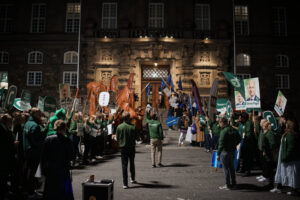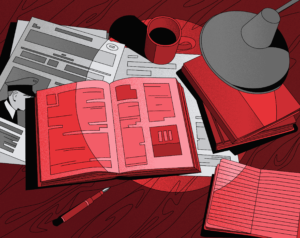By Sophie Schmalenberger
This article takes a look at the protests against the Corona restrictions and vaccine mandates in Germany during the Covid-19 pandemic and explains the affective dynamics behind them. After identifying far-right actors as central agitators and promoters of Covid-related conspiracy narratives and introducing the concept of affect for a general audience, it points out how self-victimization is the central affective dynamic behind the anti-covid movement in Germany. Furthermore, the article analyses how antisemitic and historical revisionist claims and practices, for example the wearing of a yellow star by Covid-protestors or comparisons between Nazi Germany and the current German government are perpetuating this self-victimization. To conclude, the article underlines that these Covid-protests are a threat to a pluralist and democratic society because they constitute a potential gateway to a more comprehensive far-right identity and justify (far-right) violence as necessary means of self-defense.
In early 2022, protests against Covid-related lockdowns, rules and vaccine mandates brought thousands of Germans to streets on a regular basis. In the third week of January 2022 alone, approximately 1,700 demonstrations drawing around 400,000 people were registered all over Germany. While the Eastern German state of Saxony emerged as epicenter of these so-called “Monday Walks” (Montagsspaziergänge), anti-covid demonstrations mobilized people all over the country, among others in cities and towns in the Southern German states of Baden Wurttemberg and Bavaria. While leading right-wing extremists such as Björn Höcke, head of the far-right party Alternative für Deutschland (AfD) continue to promote and participate in these protests, the overall number of participants has decreased ever since February, with currently only the hard core of conspiracist believers and agitators joining the demonstrations. The decrease in participants can be explained by a decline in salience of Covid-19 and related issues, due to the incremental loosening of restrictions in Germany on the one, and the outbreak of Russia’s war of aggression in Ukraine, dominating the news and the political agenda ever since late February 2022, on the other hand.
While the mass protests seem over for now, the surge of conspiracist mobilization during the pandemic might have severe long-term consequences not only in terms of public health. Rather, the success of the anti-Covid movement threatens the pluralist and democratic society in the longer run because the feelings mobilized and expressed in course of these protests connect to affective dynamics central to far-right radicalization and can thus be an entry-point to a more comprehensive far-right identity.
Anti-Covid Protests and the German Far-Right
Soon after the beginning of the pandemic and the first lockdown in March 2020, criticism and protest against the Covid-19 lockdowns emerged in Germany. Besides the concerns of those working in retail or the creative, catering or event industry and for whom the lockdowns had decisive financial implications, the Covid-measures triggered resistance from groups with various ideological, philosophical and conspiracist backgrounds. From spring 2020 onwards, an amorphous scene of ‘Corona-sceptics’, anti-vaxxers and so called Querdenker (lateral thinkers) emerged in Germany, consisting of esoterics, (self-declared) libertarians, right-wing extremists and seemingly ordinary German citizens claiming to fight for their personal rights and freedoms. While the boundaries between those groups are blurry, the glue that binds them together is an amalgam of often explicitly antisemitic disinformation and conspiracy narratives, including, but not restricted to the Q-Anon conspiracy narrative central to the anti-lockdown protests and movements in the US.
Within this biotope of disinformation and conspiracies, radical and extremist right-wing actors, among others the regional party Freie Sachsen, the Alternative für Deutschland (AfD) and far-right media outlets such as online blog Sezession and the print-magazine Compact have ideological incorporated and actively promote conspiracist contents via social media, particular via the messenger service Telegram. Duly, the German far-right did not only tried to piggy-back on Covid-related conspiracy myths and exploit discontent with the German government’s handling of the Covid-19 pandemic to mobilize (electoral) support after their central issue, immigration, had declined in saliency. Rather, the far-right must be understood as a driving force behind the Corona protests in Germany. The connection points and synergies between far-right ideologies and Covid-related conspiracy myths become obvious when looking the affective dimension of both.
The Affective Dimension of Far-Right Ideologies and Covid-Conspiracies
Affects are the emotional intensities and valences with which human beings relate to the outside world and can thus be understood as the ways we feel about other individuals, groups and events that we encounter. Accordingly, affects structure the subjective world we inhabit, inform our experiences and create and sustain social and cultural borders. While this might sound rather abstract, a concrete example might help to illustrate the central idea: Think, for example, of football fans watching a match of their favorite team in the stadium. The football fan relates to their favorite team, players and fellow fans in a certain affectionate, enthusiastic way, to the fans and members of the opposing team in another way, often with feelings of rivalry, maybe even dislike and at times aggression. Furthermore, identifying as loyal fan of Team A will structure the way one experiences and ‘feels into’ the match and its course. For instance, goals scored by one’s favorite team are celebrated and foul plays tolerated or down-played, while goals or a foul play by the opposing team are perceived rather differently. Moreover, decisions by the referee will not be judged objectively but based on whether one’s beloved team profits from them and one will leave the stadium either as victorious admirer of the superior team or as sad but faithful supporter of the loser.
This insight into how affective relation structure one’s subjective position and perception of the world opens up a new way of looking at both; the ideologies and narratives promoted by far-right actors and (Covid-related) conspiracy myths. It helps us to understand the diverse group of protestors as first and foremost affective community, sharing a certain way of feeling into the world, just like the fans in a football stadium. Accordingly, far-right narratives and conspiracist tropes do not only reproduce racist and antisemitic stereotypes and offer simplistic explanation for complex challenges that come with late capitalism, immigration issues or a global pandemic. They also offer a distinctive subject position, a particular way of feeling, that structures how their supporters perceive and experience the world.
Here, the central (conspiracist) narrative promoted by contemporary German far-right actors is that of an alleged “Great Replacement” of white Germans by non-European, primarily Muslim, immigrants, supposedly orchestrated by left-leaning and/or Jewish treacherous elites. This does not only mobilize fear of and hatred against racialized others, representatives of the allegedly left-wing extremist mainstream or Jews. It also offers (potential) supporters a way of feeling into the world that, besides despising, fearing and hating ethnic, religious or political ‘others’ is characterized by relating to the (individual or collective, ethno-national) self as simultaneously endangered, marginalized victim and courageous resistance fighter. A self thus, that is being oppressed and victimized, but bravely resists its subjugation, be it by taking the streets during far-right marches, voting for far-right parties, by blowing racists, antisemitic and other bigoted slurs into the social media orbit or, ultimately, by acts of violence. The affective implications of Covid-19-related conspiracy narratives are rather similar: Irrespective of whether it is about the alleged dangers or hidden purposes of Covid-vaccines or the deeply antisemitic claim that the Covid-pandemic is a orchestrated hoax by a global Jewish elite aiming to establish a New World Order through a Great Reset and subjugate all freedom-loving Germans and the rest of the world: Central to all these narratives is the position of the oppressed, yet enlightened and gutsy victim, that is offered to everyone who believes in those myths and narratives.
Self-Victimization through Historical Revisionism
Far-right actors and conspiracy promoters in Germany and around the world are constantly reproducing and sustaining the affective disposition of the victimized resistance fighter that they offer to their supporters. This is, among others, accomplished by promoting (false) comparisons and equivalences between the current pandemic and respective restrictions and past dictatorships.
In Germany, the differentiation from the Third Reich and the commemoration of Holocaust victims are central element of the state-sponsored, modern national identity while on the other hand, guilt-deflection and the desire to ‘draw a line’ under the Holocaust commemoration are also a central feature in the German dealing with the past. This constitutes a fertile ground for the strategic use of history to re-produce not only antisemitic narratives that relativize and trivialize the Shoah, but to offer individuals a way to feel into the world as innocent and threatened victims.
Indeed, far-right actors like the AfD have compared the German government under chancellor Merkel to the Nazi Regime and the GDR for years, offering their supporters the role of righteous defenders of fatherland, fighting against immigration policies and an alleged lack of freedom of expression, by equating them with 1930/40s or 1989 dissidents and resistance fighters. The equation of the current German government with the Nazi Germany and even more shockingly the drawing of comparisons between non-vaccinated individuals in contemporary Germany and the millions of brutally murdered victims of the Holocaust are a central feature of the ongoing anti-Covid demonstrations. Here, images of protestors wearing a yellow star, resembling those implemented by the Nazis to mark Jews and a prelude to their deportation and murder, have arguably become the most infamous examples of these comparisons. This constitutes not only an antisemitic trivialization of the suffering of Jews and other minorities persecuted, imprisoned and murdered during the Holocaust. These comparisons are also simultaneously expressing and re-producing the affective subject position that the German far-right and other Covid-conspiracists offer to their supporters. On the one hand they enable German conspiracy believers to reject the historical role of Germans as perpetrators, thus allowing them to live out the desire to ‘draw a line’ under the self-reflexive national identity based on the (state-sponsored) commemoration of historical guilt. Simultaneously, historical comparisons offer contemporary ‘Covid-sceptics’ to feel not only like vitally threatened, marginalized victims but also like brave resistance and freedom fighters standing ‘on the right side of history’ just like their (imagined) predecessors who resisted the Nazi or later, the GDR regime. Here, it is no coincidence that protest organizers and far-right mobilisers label their demonstrations as allegedly peaceful ‘marches and ‘walks’, a reference to the peaceful demonstrations in Leipzig and many other cities in the GDR in 1989.
Unlike the events of 1989, however, many protests against the Covid-19 restrictions and vaccine mandates have indeed not been peaceful. And needless to say, comparisons between the contemporary German government and the Nazi regime or the treatment of unvaccinated Germans and the persecution and murder of Jews in the Third Reich are factually and historically wrong. But as pointed out above, these comparisons are not meant to make rational sense, but have an affective function. Namely to enable anti-Covid protestors and conspiracy believers to feel their way into the world as oppressed victims, bravely resisting allegedly totalitarian restrictions and the threat of the pending vaccine mandates. Thus, the wearing of yellow star badges and other (antisemitic) trivializations of the Holocaust, the Third Reich or the GDR regime in course of these protests must be understood as practices that reproduce these collective sentiments of victimhood, bravery and righteous resistance against what is made to feel like a repressive (German) state and malicious global elites.
The Dangerous Potentials of Self-Victimization
Understanding the affective implications of far-right and conspiracist mobilization does in no way mean to downplay their dangerous potentials. Quite the opposite is the case. From the subjective position of the victimized, yet courageous and righteous freedom fighter, anti-democratic actions like the (ultimately unsuccessful) attempt to “storm” the German Parliament (Reichstag) in August 2020 might not feel like insurrectionist aggression but like acts of necessary and righteous defense of individual and collective freedoms. This in turn contributes to the radicalization of the scene that could be observed over the last year: On the one hand it makes the violent actions of already violent (far-right) extremists feel like an appropriate means of resistance while it encourages violence as seemingly last means of resistance among those without an extremist background. Among many other incidents, the murder of a young gas station employee, who was shot by a supporter of the anti-lockdown movement after asking him to wear a surgical mask in September 2021, tragically illustrates the (deadly) potential for violent escalations that a far-right, conspiracist way of feeling into the world can have.
While it remains to be seen whether the Covid-pandemic is indeed over, far-right conspiracist mobilization is likely to have ramifications that go beyond Covid-19 and related issues. The danger lies in the fact that the affective dispositions offered by the far-right during the pandemic can constitute an entry- point to more encompassing far-right feelings. People who have been invited to feel like oppressed and victimized resistance fighters against a state, media and experts they mistrust and perceive as enemies might not just stop feeling that way once the pandemic is over or less salient on the political agenda. Accordingly, the German far-right might be able to exploit the paranoia it has encouraged during the past two years to further radicalize anti-vaxxers and ‘Covid-sceptics’ beyond the immediate context of Covid-19 – also those who did not support the far-right prior to the pandemic. Here, the (imagined) subject position of the victimized and repressed righteous resistance fighter can potentially be transferred to other (imagined) threat scenarios, thus constituting the basis for a more all-encompassing far-right identity that does not only encourage protests against Covid-restrictions but makes acts of antisemitic, white supremacist, racist, trans- and homophobe as well as misogynist, ableist and other forms of political violence feel like legitimate last means of self-defense. Most recently, the waving of Russian flags at anti-lockdown protests in the city of Dresden and elsewhere illustrates how easily the feelings mobilized by Covid-conspiracies connect to other disinformation and can be transferred to other (political) contexts, leading to feelings of solidarity with the perpetrators of large-scale crimes of aggression and other acts of (mass) violence.
The danger for liberal democracy and the lives of those who are the targets of far-right hatred and violence then does not only come from those who look and act like stereotypical and avowed Neo-Nazis and far-right extremist. It also comes from the often invoked ‘average citizens’ who have been encouraged to feel that their liberties and ‘normal way of life’ must be defended against political enemies and marginalized others.
Sophie Schmalenberger is a PhD Candidate at Aarhus University`s School of Culture and Society (Denmark). Her research interests include far-right populism and the mainstreaming of far-right positions in Germany and Europe with a focus on the role that memory culture and affects play in extreme-right mobilization. She is co-author of the recently published chapter Tertiary Antisemitism in Social Media Posts of Germany’s Alternative für Deutschland in the edited volume Antisemitism on Social Media (2022).







